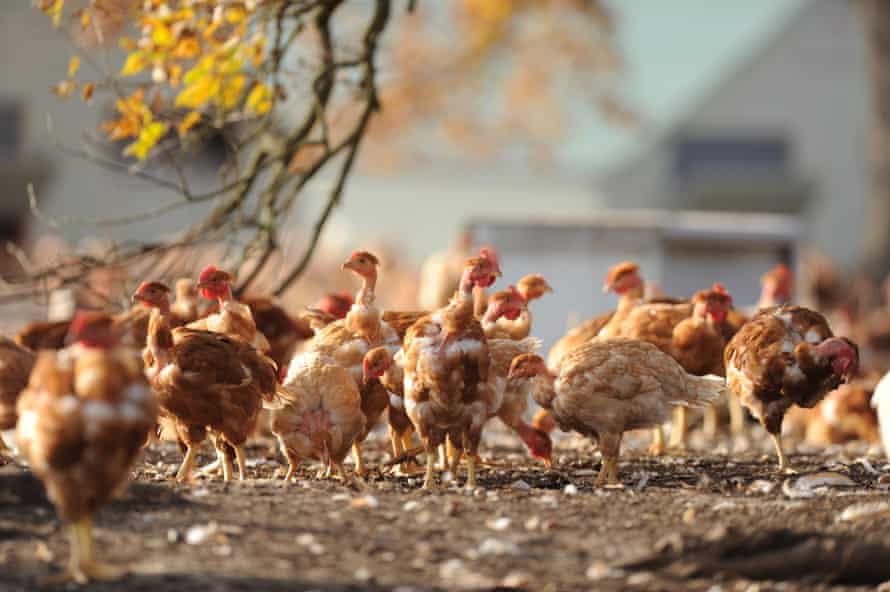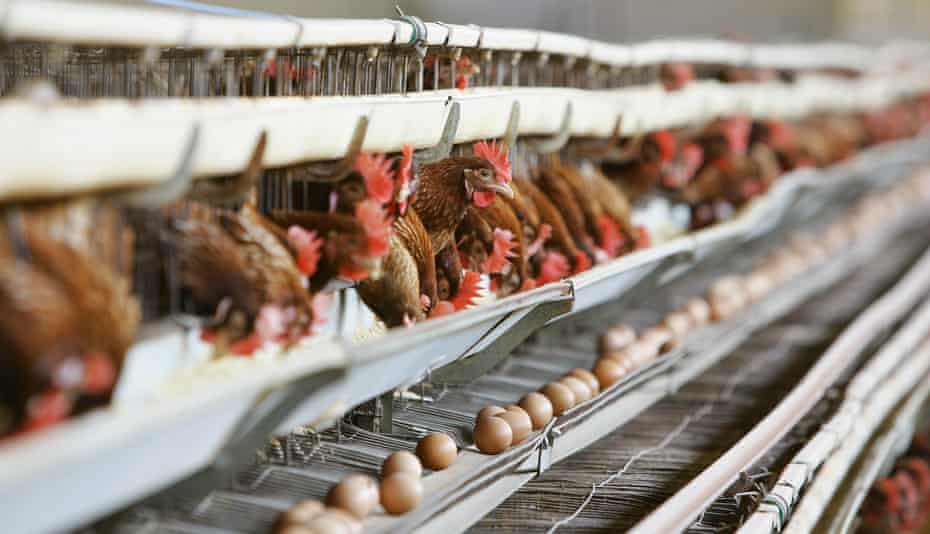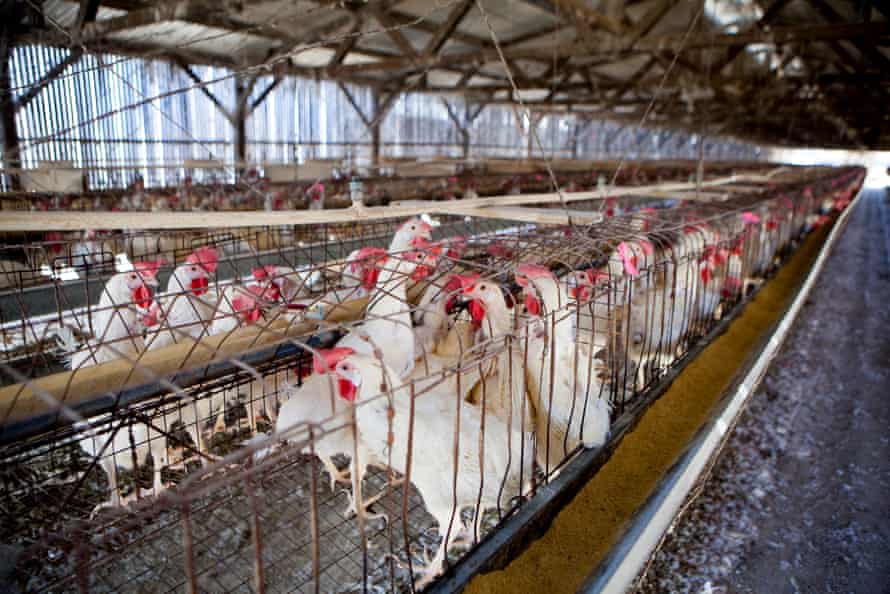Guardian Read This Never Eat Chicken Again
E very year I spend some time in a tiny apartment in Paris, seven storeys above the mayor'due south offices for the 11th arrondissement. The Place de la Bastille – the spot where the French revolution sparked political change that transformed the globe – is a x-infinitesimal walk downwards a narrow street that threads between pupil nightclubs and Chinese fabric wholesalers.
Twice a week, hundreds of Parisians crowd down it, heading to the marché de la Bastille, stretched out along the middle island of the Boulevard Richard Lenoir.
Blocks before you reach the marketplace, yous can hear it: a low hum of argument and chatter, punctuated by dollies thumping over the curbstones and vendors shouting deals. But even before you hear information technology, you lot can smell information technology: the funk of bruised cabbage leaves underfoot, the sharp sweetness of fruit sliced open for samples, the iodine tang of seaweed propping up rafts of scallops in wide rose-colored shells.
Threaded through them is one odour that I await for. Glassy and herbal, salty and slightly burned, it has so much heft that it feels physical, similar an arm slid effectually your shoulders to urge you lot to move a petty faster. It leads to a tented berth in the centre of the market and a line of customers that wraps effectually the tent poles and trails downwardly the market alley, tangling with the oversupply in front end of the blossom seller.
In the middle of the booth is a closet-size metal cabinet, propped upwardly on fe wheels and bricks. Inside the chiffonier, flattened chickens are speared on rotisserie bars that have been turning since before dawn. Every few minutes, one of the workers detaches a bar, slides off its dripping statuary contents, slips the chickens into apartment foil-lined bags, and hands them to the customers who have persisted to the caput of the line.
I can barely look to get my chicken home.

* * *
The skin of a poulet crapaudine – named considering its spatchcocked outline resembles a crapaud, a toad – shatters like mica; the flesh underneath, basted for hours by the birds dripping on to it from above, is pillowy but springy, imbued to the bone with pepper and thyme.
The starting time time I ate it, I was stunned into happy silence, likewise intoxicated by the experience to process why it felt then new. The second fourth dimension, I was delighted again –and and then, afterward, sulky and distressing.
I had eaten chicken all my life: in my grandmother'south kitchen in Brooklyn, in my parents' house in Houston, in a college dining hall, friends' apartments, restaurants and fast food places, trendy confined in cities and former-school joints on back roads in the due south. I thought I roasted a chicken pretty well myself. Merely none of them were ever similar this, mineral and lush and straight.
I thought of the chickens I'd grown up eating. They tasted similar whatever the cook added to them: canned soup in my grandmother's fricassee, her party dish; soy sauce and sesame in the stir fries my college housemate brought from her aunt'south restaurant; lemon juice when my mother worried about my father'due south blood pressure level and banned salt from the house.
This French craven tasted like muscle and blood and practice and the outdoors. Information technology tasted similar something that it was too easy to pretend it was not: similar an animal, similar a living matter. We have made it easy not to think about what chickens were before nosotros discover them on our plates or pluck them from supermarket cold cases.
I live, most of the time, less than an 60 minutes's bulldoze from Gainesville, Georgia, the self-described poultry capital of the earth, where the modern chicken industry was built-in. Georgia raises i.4bn broilers a year, making it the single biggest contributor to the most 9bn birds raised each year in the United States; if it were an independent land, it would rank in chicken production somewhere almost China and Brazil.
Nevertheless you could drive around for hours without ever knowing y'all were in the centre of chicken state unless you happened to become backside a truck heaped with crates of birds on their manner from the remote solid-walled barns they are raised in to the gated slaughter plants where they are turned into meat. That first French market craven opened my eyes to how invisible chickens had been for me, and after that, my job began to show me what that invisibility had masked.
My firm is less than 2 miles from the forepart gate of the Centers for Disease Command and Prevention, the federal agency that sends disease detectives racing to outbreaks all over the world. For more than a decade, one of my obsessions as a journalist has been following them on their investigations – and in long late-dark conversations in the United states and Asia and Africa, with physicians and veterinarians and epidemiologists, I learned that the chickens that had surprised me and the epidemics that fascinated me were more closely linked than I had ever realized.
I discovered that the reason American chicken tastes then different from those I ate everywhere else was that in the United states of america, we brood for everything but flavor: for affluence, for consistency, for speed. Many things made that transformation possible.
But as I came to sympathise, the single biggest influence was that, consistently over decades, we take been feeding chickens, and near every other meat beast, routine doses of antibiotics on almost every 24-hour interval of their lives.

Antibiotics exercise non create blandness, but they created the conditions that allowed craven to be banal, assuasive us to plow a skittish, agile backyard bird into a fast-growing, irksome-moving, docile cake of poly peptide, as muscle-jump and top-heavy as a bodybuilder in a kids' drawing. At this moment, most meat animals, across near of the planet, are raised with the assist of doses of antibiotics on nearly days of their lives: 63,151 tons of antibiotics per year, near 126m pounds.
Farmers began using the drugs because antibiotics immune animals to convert feed to tasty muscle more efficiently; when that effect fabricated it irresistible to pack more livestock into barns, antibiotics protected animals confronting the likelihood of disease. Those discoveries, which began with chickens, created "what we choose to phone call industrialized agriculture", a poultry historian living in Georgia proudly wrote in 1971.
Chicken prices roughshod so low that it became the meat that Americans eat more than any other – and the meat most likely to transmit nutrient-borne disease, and also antibody resistance, the greatest slow-brewing health crisis of our fourth dimension.
For most people, antibiotic resistance is a hidden epidemic unless they accept the misfortune to contract an infection themselves or have a family member or friend unlucky enough to become infected.
Drug-resistant infections have no celebrity spokespeople, negligible political back up and few patients' organizations advocating for them. If nosotros think of resistant infections, we imagine them as something rare, occurring to people different us, whoever we are: people who are in nursing homes at the end of their lives, or dealing with the drain of chronic affliction, or in intensive-intendance units after terrible trauma. But resistant infections are a vast and common problem that occur in every part of daily life: to children in daycare, athletes playing sports, teens going for piercings, people getting healthy in the gym.
And though common, resistant bacteria are a grave threat and getting worse.
They are responsible for at to the lowest degree 700,000 deaths around the world each year: 23,000 in the United States, 25,000 in Europe, more than 63,000 babies in India. Beyond those deaths, bacteria that are resistant to antibiotics cause millions of illnesses – 2m annually just in the Usa – and cost billions in healthcare spending, lost wages and lost national productivity.
It is predicted that by 2050, antibiotic resistance volition cost the earth $100tn and will cause a staggering 10m deaths per twelvemonth.
Disease organisms take been developing defenses against the antibiotics meant to kill them for as long every bit antibiotics have existed. Penicillin arrived in the 1940s, and resistance to it swept the globe in the 1950s.
Tetracycline arrived in 1948, and resistance was nibbling at its effectiveness before the 1950s concluded. Erythromycin was discovered in 1952, and erythromycin resistance arrived in 1955. Methicillin, a lab-synthesized relative of penicillin, was developed in 1960 specifically to counter penicillin resistance, still within a year, staph bacteria developed defenses against it also, earning the bug the name MRSA, methicillin-resistant Staphylococcus aureus.
After MRSA, in that location were the ESBLs, extended-spectrum beta-lactamases, which defeated not only penicillin and its relatives just also a large family of antibiotics called cephalosporins. And after cephalosporins were undermined, new antibiotics were achieved and lost in turn.
Each fourth dimension pharmaceutical chemistry produced a new class of antibiotics, with a new molecular shape and a new mode of action, bacteria adjusted. In fact, as the decades passed, they seemed to adapt faster than before. Their persistence threatened to inaugurate a mail-antibiotic era, in which surgery could be too unsafe to effort and ordinary health problems – scrapes, molar extractions, broken limbs – could pose a deadly risk.
For a long time, it was assumed that the boggling unspooling of antibiotic resistance effectually the world was due just to misuse of the drugs in medicine: to parents begging for the drugs fifty-fifty though their children had viral illnesses that antibiotics could not help; physicians prescribing antibiotics without checking to see whether the drug they chose was a good friction match; people stopping their prescriptions halfway through the prescribed grade because they felt better, or saving some pills for friends without wellness insurance, or buying antibiotics over the counter, in the many countries where they are available that way and dosing themselves.
Merely from the earliest days of the antibody era, the drugs accept had another, parallel utilize: in animals that are grown to become nutrient.
Eighty per centum of the antibiotics sold in the United States and more than half of those sold around the world are used in animals, non in humans. Animals destined to be meat routinely receive antibiotics in their feed and h2o, and about of those drugs are not given to treat diseases, which is how we use them in people.
Instead, antibiotics are given to make nutrient animals put on weight more speedily than they would otherwise, or to protect food animals from illnesses that the crowded conditions of livestock production brand them vulnerable to. And nearly two-thirds of the antibiotics that are used for those purposes are compounds that are also used against human disease – which ways that when resistance confronting the farm apply of those drugs arises, it undermines the drugs' usefulness in homo medicine also.

Resistance is a defensive adaptation, an evolutionary strategy that allows bacteria to protect themselves confronting antibiotics' power to kill them. It is created by subtle genetic changes that allow organisms to counter antibiotics' attacks on them, altering their cell walls to go along drug molecules from attaching or penetrating, or forming tiny pumps that eject the drugs after they have entered the cell.
What slows the emergence of resistance is using an antibiotic conservatively: at the correct dose, for the right length of fourth dimension, for an organism that will be vulnerable to the drug, and not for whatsoever other reason. Most antibiotic use in agriculture violates those rules.
Resistant bacteria are the result.
* * *
Antibiotic resistance is like climate change: it is an overwhelming threat, created over decades by millions of private decisions and reinforced by the actions of industries.
It is also similar climate change in that the industrialized west and the emerging economies of the global southward are at odds. One quadrant of the world already enjoyed the cheap poly peptide of factory farming and now regrets it; the other would like not to forgo its hazard. And it is additionally like climate change because any action taken in hopes of ameliorating the problem feels inadequate, like ownership a fluorescent lightbulb while watching a polar bear drown.
But that it seems difficult does not hateful it is not possible. The willingness to relinquish antibiotics of farmers in the netherlands, also as Perdue Farms and other companies in the United States, proves that industrial-scale production tin can be achieved without growth promoters or preventive antibiotic utilise. The stability of Maïsadour and Loué and White Oak Pastures shows that medium-sized and small farms can secure a place in a remixed meat economy.
Whole Foods' pivot to slower-growing craven – birds that share some of the genetics preserved by Frank Reese – illustrates that removing antibiotics and choosing birds that do not need them returns biodiversity to poultry production. All of those achievements are signposts, pointing to where craven, and cattle and hogs and farmed fish after them, need to go: to a manner of production where antibiotics are used as infrequently as possible – to care for sick animals, just not to fatten or protect them.
That is the way antibiotics are now used in man medicine, and information technology is the but way that the utility of antibiotics and the risk of resistance can be fairly balanced.
Excerpted from Big Chicken by Maryn McKenna published by National Geographic on 12 September 2017. Available wherever books are sold.
Plucked! The Truth About Chicken by Maryn McKenna is published in the United kingdom of great britain and northern ireland by Trivial, Brown and is now bachelor in eBook @£14.99, and is published in Trade Format @£14.99 on one Feb 2018.
Source: https://www.theguardian.com/lifeandstyle/2017/oct/13/can-never-eat-chicken-again-antibiotic-resistance
0 Response to "Guardian Read This Never Eat Chicken Again"
Post a Comment